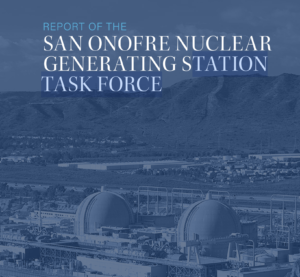Nuclear Safety Issues
A primary focus of the Samuel Lawrence Foundation is the environmental threat arising from nuclear waste.
Risks of San Onofre Nuclear Waste Dump are Real
Time is not on our side
- Low-quality canisters are only designed for decades
- Radioactive waste expected to remain on the coastline for centuries
- Radioactive waste remains deadly for more than 200,000 years
People have lost trust in Edison’s management
- Consistent pattern of risk denial and lack of transparency
- Violations and cover-ups occurred and exposed by whistleblowers
- Received most severe citation from regulators for any safety violation
Worst possible storage location
- Stored 100 feet from ocean and just 18 inches above ground water
- Thin-walled canisters are susceptible to corrosion cracking from salty air
- Risks of sea level rise, earthquakes, landslides, tsunamis, and terrorist attacks
Potential for radiation exposure
- Storage canisters can fail from aging, natural disasters and human-caused means
- Damaged canisters can release dangerous radiation into the air, land, and ocean
- 5/8 inch, thin-walled canisters are scratched and gouged when lowered into storage
- Canisters cannot be adequately monitored, inspected, repaired, or replaced
- No emergency plans in place to protect public in event of radiation release
The Solutions are Straightforward
Install most sensitive radiation and leak detection technology
Construct on-site handling facility to contain, repair, and replace canisters
Replace thin-walled canisters with safer 10- to 19-inch thick-walled, transportable casks
The Guardian: ‘A combination of failures:’ why 3.6m pounds of nuclear waste is buried on a popular California beach
Failures at San Onofre circulated on the streets of London and across the internet with the publication of an article in The Guardian newspaper. The venerable English daily launched in 1812 and today its online edition reaches readers worldwide.
In the article, reporter Kate Mishkin picks apart San Onofre’s political and regulatory gridlock and history of close calls. You would be hard pressed to find a better summary of the dangerous decisions that led to the current crisis at San Onofre, an environmental disaster waiting to happen.
Admiral Hering discloses NRC and Edison’s Mismanagement
In May 2019, technical experts and community advocates held a congressional briefing in Washington, DC entitled, “Decommissioning: A New Era in the U.S. Nuclear Power Industry; a Critical Need for Congressional Oversight” (Link). They shared insights, concerns, and solutions for improving the nation’s current precarious nuclear safety system in the United States.
Participants included Greg Jaczko, PhD, former chair of the U.S. NRC; Rear Admiral Len Hering, Sr. USN (Ret.); and others.
San Onofre Nuclear Waste Major Problems
Authors: T. Enlgish, PhD, S. Chakraborty, PhD, Len Hering Sr. RADM USN
Most serious of the issues facing the interim storage of nuclear waste at S.O.N.G.S. include the gouging damage to fully-loaded steel canisters upon downloading into the storage vault. These 54-ton thin-walled steel canisters are loaded with nuclear wsaste in wet storage – spent fuel pools – and are transported to the on-site concrete storage vault, adjacent to the reactor domes.
With the Birnell hardness scale calculations our team demonstrates the depth and width of cansiter gouges upon downloading into the storage system. The current downloading procedure and on-site storage configuration provides the factors necessary to create gouges in the external steel walls of the canisters: operators have no visibility of the canister during downloading and precise adjustments to canister orientation cannot be made.
These gouges remain undetected and unrepaired due to the lack of thorough inspection and monitoring at the San Onofre Independent Spent Fuel Storage Installations (ISFSIs). The preliminary findings are found in this report.
T. English, PhD, S. Chakraborty PhD, Len Hering Sr. RADM USN
Potential Impact: A Waste Storage Accident Could Cost $13.4 Trillion
In early 2019 SLF released two expert reports on the potential economic impacts and the technical problems of the San Onofre nuclear waste storage.
A collaboration of physicists, former military personnel, and engineers with considerable nuclear experience issued the reports. A potential impact of a nuclear waste accident at San Onofre could exceed $13.4 trillion.
R. McCann PhD, E. Stryjewski PhD
2020 S.O.N.G.S. TASK FORCE REPORT
The San Onofre Nuclear Generating Task Force Report was released this week after 18 months of fact-finding. SLF is proud to have joined scientists, policy makers and community leaders in preparing the document. Thanks so much to Rep. Mike Levin for bringing us together. We will continue to appreciate his leadership as he advances eight key policy recommendations contained in the report.
We encourage you to review the report and share it widely:
Containment Challenges
January 2, 2019: This KPBS TV interview describes the problems with the storage of spent nuclear fuel at the San Onofre Nuclear Generating Station site using thin-walled canisters.
Nuclear waste continues to accumulate across the nation with no permanent repository on the horizon. However, interim storage with the Holtec system used by Edison at San Onofre is unacceptable.
The current thin-wall steel canister design is welded shut, and it cannot be inspected, monitored, nor repaired. The metal
In August 2018, a whistleblower reported that a fully-loaded canister came within a quarter-inch of falling 18 feet. The Nuclear Regulatory Commission (NRC) investigated Edison mismanagement and the Holtec canister system. Regulators have since ordered a halt to the loading of Edison’s spent nuclear waste into the seaside storage vault.
SLF supports a fully independent and transparent review. A current pursuit is to gather quantitative research about nuclear waste storage. Dry cask storage is only experimental. The technology is so new and has not been tested with radioactive waste over a long-term scientific study.
“If Holtec’s system is damaging the canisters, that’s a defective system,” said Torgen Johnson of the Del Mar-based Samuel Lawrence Foundation. “In any engineered system if you have metal-to-metal abrasion that wasn’t intended, you have a defective system and that system needs to be recalled. Clearly, we have a defective system here.”
Nuclear Waste by the Numbers
3.6 million pounds of nuclear waste stored at San Onofre Nuclear Generating Station
8.4 million people living within 50 miles of the plant
108 feet between nuclear waste and the ocean
2 feet – mean water table below nuclear waste, with rising seas
37 nuclear waste fuel assemblies packed into each steel 50-ton canister
200,000 years – radiation from Uranium, Plutonium, Cesium remains lethal
Source: Nuclear Regulatory Commission, Los Angeles Times, San Diego Union-Tribune
Join Our Supporters
We take great pride in our mission and accomplishments. SLF incubates young, change-making organizations. Find out how your donation can have meaningful impact to our science, art and environmental programs!



